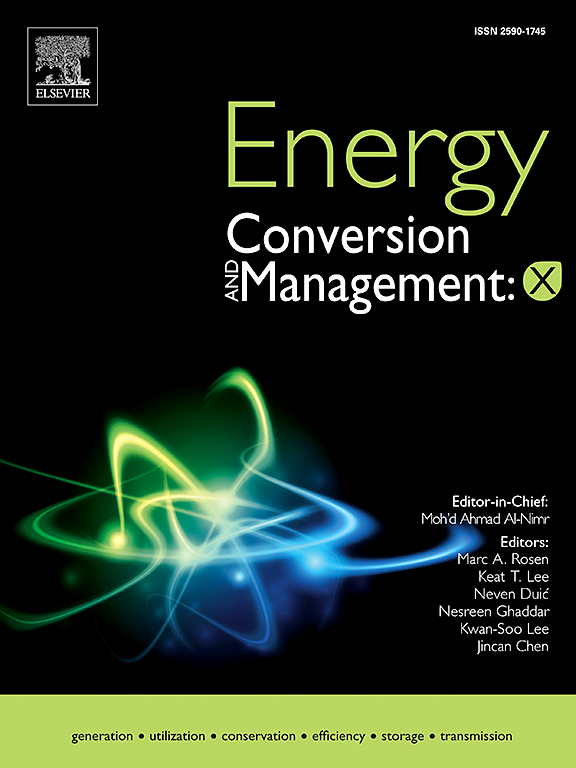Salinity-gradient based osmotic energy conversion enhanced by waste heat generated from proton exchange membrane electrolyzer
IF 10.9
1区 工程技术
Q1 ENERGY & FUELS
引用次数: 0
Abstract
Proton exchange membrane electrolyzer is an essential device to generate hydrogen from water. However, a huge amount of low-grade waste thermal energy is generated during hydrogen production process of proton exchange membrane electrolyzer. Furthermore, osmotic energy conversion is capable of harnessing salinity-gradient energy in natural water sources to produce electricity. Nevertheless, salinity-gradient osmotic energy conversion suffers from an issue of relatively low power density. The current work reports a hybrid system that integrates a proton exchange membrane electrolyzer with an osmotic energy conversion module, harnessing the waste heat produced by the electrolyzer to improve both osmotic power density and overall systematic energy efficiency. A one-dimensional finite difference model is firstly developed to analyze performance of proton exchange membrane electrolyzer. Then, a three-branch bipolar plate of proton exchange membrane electrolyzer is designed to enhance heat transfer between water and its electrodes for waste heat utilization. When the waste heat generated during water electrolysis is used to raise up freshwater pumped into osmotic energy conversion device from 20 °C to 40.3 ℃, 43.9 ℃, and 47.5 ℃, the corresponding osmotic power density using graphene oxide membrane is elevated from 6.32 W/m2 to 9.82 W/m2, 10.67 W/m2, and 11.54 W/m2 by 55.4 %, 68.8 %, and 82.6 %, respectively. The current work introduces a promising strategy for enhancing salinity-gradient osmotic power generation performance by effectively harnessing waste thermal energy produced within proton exchange membrane electrolyzer during hydrogen production, which shows great potential for industrial renewable energy applications.

质子交换膜电解槽余热增强基于盐度梯度的渗透能转换
质子交换膜电解槽是水制氢的重要设备。但质子交换膜电解槽制氢过程中产生大量低品位废热。此外,渗透能量转换能够利用天然水源中的盐度梯度能量来发电。然而,盐度梯度渗透能量转换存在功率密度相对较低的问题。目前的工作报告了一种混合系统,该系统集成了质子交换膜电解槽和渗透能量转换模块,利用电解槽产生的废热来提高渗透功率密度和整体系统能源效率。首次建立了质子交换膜电解槽性能的一维有限差分模型。然后,设计了质子交换膜电解槽的三支双极板,增强了水与电极之间的传热,实现了余热的利用。利用电解废热将泵入渗透能转换装置的淡水从20℃提高到40.3℃、43.9℃和47.5℃,氧化石墨烯膜的渗透功率密度分别从6.32 W/m2提高到9.82 W/m2、10.67 W/m2和11.54 W/m2,分别提高55.4%、68.8%和82.6%。本研究介绍了一种有效利用质子交换膜电解槽制氢过程中产生的废热来提高盐梯度渗透发电性能的有前景的策略,显示出巨大的工业可再生能源应用潜力。
本文章由计算机程序翻译,如有差异,请以英文原文为准。
求助全文
约1分钟内获得全文
求助全文
来源期刊

Energy Conversion and Management
工程技术-力学
CiteScore
19.00
自引率
11.50%
发文量
1304
审稿时长
17 days
期刊介绍:
The journal Energy Conversion and Management provides a forum for publishing original contributions and comprehensive technical review articles of interdisciplinary and original research on all important energy topics.
The topics considered include energy generation, utilization, conversion, storage, transmission, conservation, management and sustainability. These topics typically involve various types of energy such as mechanical, thermal, nuclear, chemical, electromagnetic, magnetic and electric. These energy types cover all known energy resources, including renewable resources (e.g., solar, bio, hydro, wind, geothermal and ocean energy), fossil fuels and nuclear resources.
 求助内容:
求助内容: 应助结果提醒方式:
应助结果提醒方式:


